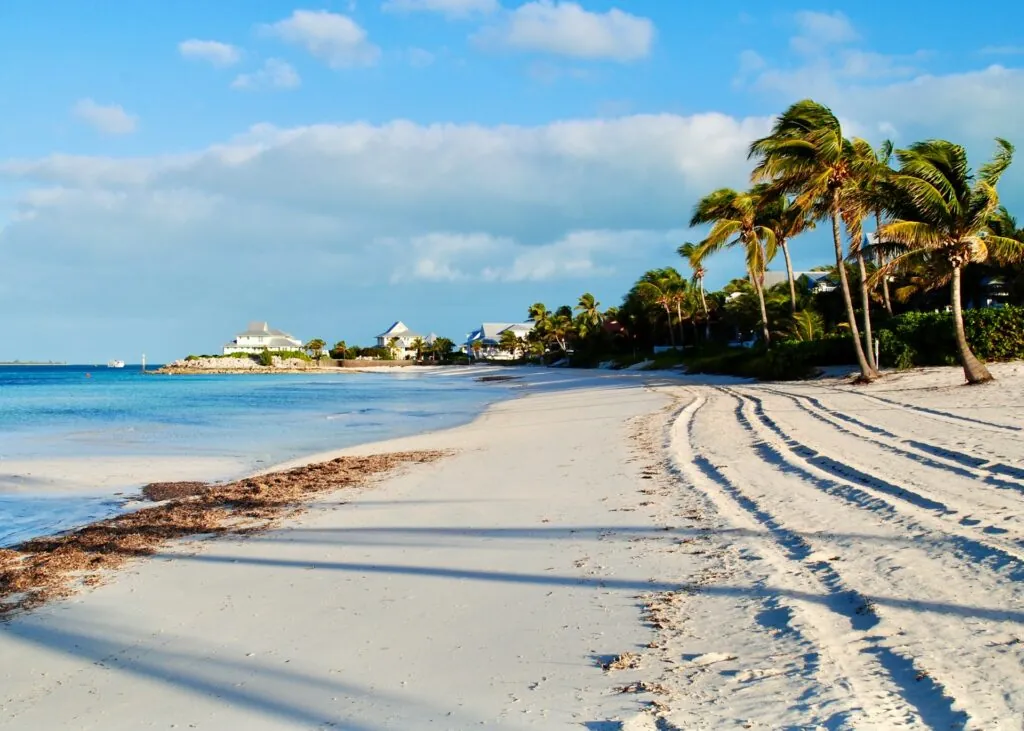Understanding the weather is crucial for planning a successful trip to the Bahamas. Climate conditions significantly impact travel experiences, from beach days to outdoor activities. Knowing what to expect each month helps travelers pack appropriately and choose the ideal time for their visit.
The Bahamas, a stunning archipelago in the Atlantic, boasts a tropical climate. This means warm temperatures prevail throughout the year. However, distinct seasons bring variations in rainfall, humidity, and potential for tropical storms.
Choosing the optimal time to visit depends on individual preferences. Some travelers prioritize sunshine and low humidity, while others seek fewer crowds and lower prices. Weather patterns play a key role in these decisions.
This article provides a comprehensive overview of Bahamas weather by month. It covers general climate patterns, seasonal variations, and specific conditions for each month. Readers will find detailed information to help them decide when to visit this tropical destination. Links to individual monthly guides offer deeper insights into specific weather patterns.
Quick Glance: Monthly Weather in the Bahamas
| Month | Avg. Temp (°C/°F) | Avg. Rainfall (mm/inches) | Travel Season |
|---|---|---|---|
| January | 21/70 | 48/1.9 | Peak |
| February | 22/72 | 43/1.7 | Peak |
| March | 23/73 | 41/1.6 | Peak |
| April | 24/75 | 58/2.3 | Peak |
| May | 26/79 | 137/5.4 | Shoulder |
| June | 27/81 | 216/8.5 | Low |
| July | 28/82 | 157/6.2 | Low |
| August | 28/82 | 160/6.3 | Low (Hurricane) |
| September | 28/82 | 170/6.7 | Low (Hurricane) |
| October | 26/79 | 168/6.6 | Low (Hurricane) |
| November | 24/75 | 84/3.3 | Shoulder |
| December | 22/72 | 51/2.0 | Peak |
The Bahamas climate transitions throughout the year. Temperatures remain warm, but humidity and rainfall vary significantly. The dry season offers pleasant conditions, while the rainy season brings higher chances of precipitation and tropical activity.
What’s the Weather Like in the Bahamas Year-Round?
The Bahamas experiences a tropical savanna climate. This results in warm temperatures throughout the year with distinct wet and dry seasons. The islands are also susceptible to hurricanes during a specific period.
The dry season typically runs from December to April. This period features lower humidity and less rainfall, making it a popular time for visitors. Temperatures are comfortable, rarely reaching extreme highs.
The rainy season extends from May to November. During these months, humidity increases, and afternoon showers or thunderstorms are common. While rain occurs, it often comes in brief bursts rather than prolonged periods.
Hurricane season in the Atlantic runs from June 1 to November 30. The peak months for potential hurricane activity in the Bahamas are generally August, September, and October. Travelers visiting during this time should monitor weather forecasts closely.
Water temperatures around the Bahamas remain inviting year-round. They typically range from the low 70s Fahrenheit in winter to the mid-80s Fahrenheit in summer. This allows for comfortable swimming and water sports regardless of the month.
Best Time to Visit the Bahamas
Determining the best time to visit the Bahamas depends on traveler priorities. Factors like weather preferences, crowd levels, and budget play a significant role. Different times of the year offer distinct advantages.
The high season aligns with the dry season, from December to April. This period offers the most favorable weather conditions with plenty of sunshine and low humidity. However, it also sees the largest crowds and highest prices for flights and accommodation.
Shoulder seasons, like May and November, can offer a good balance. The weather is generally pleasant, though with a higher chance of rain than the peak season. Prices may be slightly lower, and crowds are less dense.
The low season coincides with the rainy and hurricane seasons (June to October). This period offers the lowest prices and fewest crowds. Travelers willing to risk potential weather disruptions can find significant travel deals.
Various events and festivals occur throughout the year. Planning a visit around these can enhance the trip experience. Checking local event calendars helps align travel dates with cultural happenings.
Budget travelers often find the low season most appealing. Reduced demand leads to lower costs for flights, hotels, and activities. Flexibility with travel dates is key to securing the best deals during this time.
Month-by-Month Weather in the Bahamas
Here is a summary of Bahamas monthly weather conditions. Each month presents unique characteristics for visitors. Clicking the links provides more detailed information for planning.
January: Bahamas weather in January is cool and dry. Average temperatures are around 70°F (21°C). It is part of the peak travel season with low rainfall and plenty of sunshine. More information
February: February in the Bahamas sees similar conditions to January. Temperatures remain pleasant, averaging 72°F (22°C). Low humidity and minimal rain make it ideal for outdoor activities. More information
March: Bahamas weather in March is warm and sunny. The average temperature rises slightly to 73°F (23°C). It continues the dry season trend with low precipitation. More information
April: April marks the end of the dry season. Average temperatures reach 75°F (24°C). Rainfall begins to increase slightly towards the end of the month. More information
May: May is the start of the rainy season. Bahamas weather in May becomes warmer and more humid, averaging 79°F (26°C). Afternoon showers are more frequent but usually brief. More information
June: June is hot and wet in the Bahamas. Average temperatures are around 81°F (27°C). This month sees significant rainfall and is the official start of hurricane season. More information
July: Bahamas weather in July remains hot and humid. The average temperature is 82°F (28°C). Rainfall is high, often in the form of thunderstorms. More information
August: August is one of the hottest months. Bahamas weather in August averages 82°F (28°C). It falls within the peak of hurricane season with high humidity and frequent rain. More information
September: September is another hot and wet month. Bahamas weather in September averages 82°F (28°C). It is historically the peak month for hurricane activity. More information
October: October sees temperatures begin to cool slightly. Bahamas weather in October averages 79°F (26°C). Rainfall remains high, and it is still within hurricane season. More information
November: November is the end of the rainy season. Bahamas weather in November averages 75°F (24°C). Humidity decreases, and rainfall significantly drops. More information
December: December marks the return of the dry season. Bahamas weather in December averages 72°F (22°C). It is a popular time to visit with pleasant temperatures and low rainfall. More information
What to Pack for the Bahamas Based on the Weather
Packing for the Bahamas requires considering the time of year. Different seasons necessitate different clothing and gear. Being prepared ensures a comfortable and enjoyable trip.
During the dry season (December to April), lightweight clothing is suitable. Pack swimwear, shorts, t-shirts, and sundresses. A light jacket or sweater may be needed for cooler evenings.
For the rainy season (May to November), include items for wet weather. A lightweight rain jacket or umbrella is advisable. Quick-drying clothing can be beneficial due to higher humidity.
Sun protection is essential year-round. Pack high SPF sunscreen, a wide-brimmed hat, and sunglasses. The tropical sun is strong, even on cloudy days.
Consider the humidity, especially during the warmer months. Choose breathable fabrics like cotton or linen. This helps stay comfortable in the tropical climate.
If traveling during hurricane season, pack essentials in case of delays or disruptions. Keep important documents accessible. Follow local guidance and weather updates closely.
Tips for Traveling During Rainy or Hurricane Season
Traveling during the rainy or hurricane season can offer benefits like lower prices. However, it requires careful planning and awareness of potential weather risks. Taking precautions is important.
Rainy season showers are often short-lived. They typically occur in the afternoon and clear up quickly. This means that even on rainy days, there is usually plenty of sunshine.
Hurricane season poses a more significant risk. While direct hits are not frequent, tropical storms can cause disruptions. Travelers should purchase travel insurance that covers weather-related cancellations.
Monitor official weather sources like the National Hurricane Center. Stay informed about any developing systems. Airlines and hotels often have policies for changes during hurricane threats.
Have a plan in case of severe weather. Know the location of shelters if needed. Follow instructions from local authorities and hotel staff.
Indoor activities are available on rainy days. Explore museums, art galleries, or local markets. Enjoy spa treatments or dining at restaurants.
Frequently Asked Questions About Bahamas Weather
Here are answers to common questions about the Bahamas climate. Understanding these points helps clarify weather expectations. This section addresses key concerns for travelers.
Q: Is it always warm in the Bahamas?
A: Yes, the Bahamas has a tropical climate with warm temperatures year-round. Average daily temperatures rarely drop below 70°F (21°C). The water also remains warm and suitable for swimming.
Q: When is hurricane season in the Bahamas?
A: Hurricane season runs from June 1 to November 30. The highest risk is typically from August through October. Travelers should be aware of this period.
Q: What is the rainiest month in the Bahamas?
A: Historically, June and September tend to be the rainiest months. These months see the highest average rainfall. However, rain often comes in short, heavy bursts.
Q: Does it rain all day during the rainy season?
A: No, during the rainy season, rain typically occurs as brief afternoon showers or thunderstorms. Prolonged periods of rain are less common. Sunshine is still expected on most days.
Q: What is the driest time of year?
A: The driest period in the Bahamas is generally from December to April. These months experience the lowest average rainfall. This coincides with the peak travel season.
Conclusion
Planning a trip to the Bahamas involves considering the weather by month. Understanding the distinct seasons helps travelers choose the best time to visit based on their preferences. The dry season offers ideal conditions, while the rainy season provides budget advantages.
This guide provides a solid foundation for understanding Bahamas monthly weather. From temperature trends to hurricane season, key information is covered. For detailed planning, explore the individual monthly weather guides linked throughout this article.
Ultimately, the best time to visit the Bahamas depends on what you seek in a vacation. Whether it’s perfect sunshine, fewer crowds, or lower costs, the islands offer something for every traveler throughout the year. Use this information to plan your ideal Bahamas getaway.


